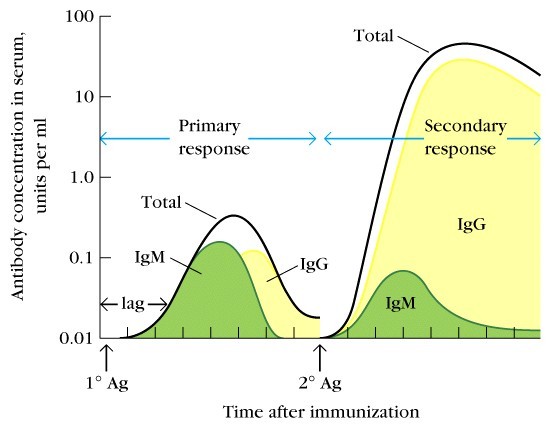Inside your body, designated cells and specialized proteins work together to form your immune system, defending you against infection. The immune system is located all over the body in order to provide quick immune responses wherever infection occurs. The immune cells travel through blood and lymphatic system vessels. Our immune system has primary immune response as well as secondary response. To enable communication between immune cells, there are special structures within the lymph nodes and the spleen.
What Is the Primary Immune Response?
To protect you from bacteria, viruses, and other foreign substances (known as antigens), the immune system needs to recognize these substances and develop a response.
Primary Response
Upon initial exposure to an antigen, a primary response occurs. After a latent period, usually lasting several days, specific antibodies begin to appear in the blood.
Secondary Response
The next and subsequent times you encounter this antigen, your body produces a secondary immune response. This will be more powerful, develop more rapidly, and require less antigens to trigger the reaction.
Difference Between Primary and Secondary Immune Response

4 Stages of Primary Immune Response
When somebody is exposed to an antigen they have never encountered before, a relatively brief, weak immune response, the primary immune response, develops. This can be broken down into four stages: the lag, exponential, steady state, and declining phases.
- Lag (latent) phase
This is the time from initial antigen exposure to when antibodies are detected in the blood, and takes about a week. In this time, specialized B and T cells are activated by contact with the antigen.
- Exponential phase
Here, there is a sharp rise in the levels of antibodies, which are secreted by large numbers of plasma cells (differentiated B cells).
- Steady state (plateau) phase
The antibody levels stay relatively constant due to the continuous secretion of antibodies to replenish any that have degraded.
- Declining phase
Antibody levels slowly decrease, due to existing plasma cells dying off, with no new plasma cells generated to replace them. The immunogen has probably been eliminated from the body, so no further antibody production is needed.
Secondary Immune Response
For second and subsequent encounters with similar antigens, secondary (anamnestic) immune responses occur. Here, the lag phase is shorter, and high and steady levels of antibodies are generated within a few days. This is due to antigen-specific memory T and B cells, originally produced during the primary response.
Due to the rapidness of the secondary immune response, the antigen can be eliminated from the body fairly soon after it has entered, and before it causes disease. The antibodies produced remain in circulation longer to ensure the infection has disappeared.
Comparison Between Primary and Secondary Immune Response
|
Primary Immune Response |
Secondary Immune Response |
|---|---|
|
After initial exposure to a foreign antigen, there is a lag phase where B cells are differentiating into plasma cells, but not yet producing antibodies. Antibody generation can take anything from 2 days to several months. |
If a previously encountered antigen enters the body again, a few days up to several years later, a secondary immune response develops. This time, the lag phase is greatly reduced, to about 3-4 days. |
|
Low quantities of antibodies are normally secreted. |
High levels of antibodies are produced. |
|
After a while, the amount of antibody decreases to minimal levels. |
Antibody levels remain elevated for longer. |
|
Antibodies are mostly IgM, but some IgG antibodies are produced. |
IgGs are the main antibody secreted, with some small amounts of IgM sometimes. |
Watch this video to understand the Primary and Secondary Immune Responses.
